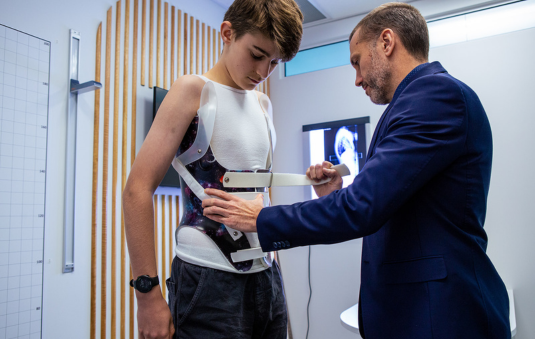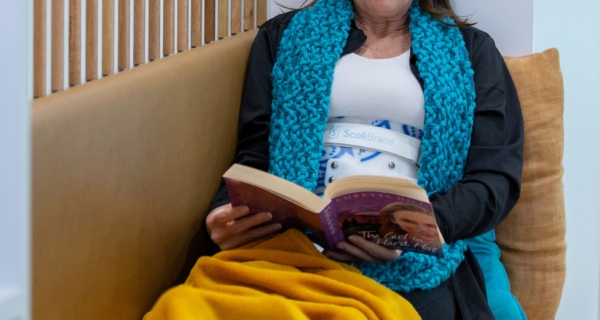Hyperkyphosis, often referred to as an excessive forward curvature of the thoracic spine, can significantly impact an individual’s quality of life. One specific type, Scheuermann’s Disease, is a condition characterised by a pronounced kyphotic curve and vertebral wedging. Here we will explore the effectiveness of bracing as a non-surgical intervention for hyperkyphosis and Scheuermann’s Disease.
Understanding Hyperkyphosis and Scheuermann’s Disease
Hyperkyphosis is typically identified when the thoracic spine curvature exceeds 40 degrees (1). Scheuermann’s Disease, a common form of hyperkyphosis in adolescents, involves more rigid deformity with vertebral body wedging and irregular endplates (2). Symptoms can include back pain, stiffness, and, in severe cases, cardiopulmonary issues due to the spine’s curvature affecting the thoracic cavity.
The Role of Bracing
Bracing is a non-invasive treatment aimed at halting the progression of spinal curvature during growth periods. The principle behind bracing is to provide external support, maintain the spine in a more aligned position, and potentially allow for correction over time (3).
What is the Latest on Bracing Effectiveness for Hyperkyphosis?
Several studies have demonstrated the efficacy of bracing in managing hyperkyphosis and Scheuermann’s Disease, particularly when initiated early.

- Findings from Lowe (2007) highlight that brace treatment is almost always successful in patients with hyperkyphosis between 55 and 80 degrees if the diagnosis is made and brace treatment is implemented before skeletal maturity (3).
- A study by Tsirikos et al. (2011) reviewed the outcomes of 67 adolescents with Scheuermann’s kyphosis treated with a brace. The results showed significant improvement in the kyphotic angle, with an average reduction of 15 degrees after 18 months of bracing (4).
- In addition to bracing for hyperkyphosis in adolescents, research has shown that patients aged 60+ who are braced for hyperkyphosis experience an improvement in balance, spinal deformity and pain (5).
Overall, clinical experience has also demonstrated that patients that adhere to the bracing regimen experience better results in regards to reduction of curve size and pain.
Is Bracing More Effective than Observation or Surgery?
Surgery certainly plays a role in the treatment of these patients when the curve gets severe. However if the patient is diagnosed early then it’s certainly wise to recommend a protocol of bracing combined with a specific exercise program, like ScoliBalance®, for this condition. The exercise protocol can also be combined with bracing where required.
Clinical Insights and Recommendations
- Early detection and treatment initiation during growth spurts are critical. The spine is more malleable during these periods, allowing for more effective curvature correction and stabilization (3).
- Educating patients and their families about the importance of bracing, its benefits, and potential challenges is vital for ensuring compliance. Psychological support can help mitigate any negative impacts on mental health and self-esteem (6).
- Compliance with brace wear is essential in terms of curve improvement and successful treatment. When bracing, a minimum of 16 hours of brace wear per day is required to ensure adequate results (7).
- Appropriate Treatment: Combining bracing with exercise for hyperkyphosis can enhance outcomes. This combination can significantly improve clinical and radiological parameters (8).
- Regular monitoring by healthcare professionals ensures that the brace remains effective and adjustments are made as needed. Follow-ups should continue even after discontinuation of the brace to monitor for any potential recurrence of curvature.
- Bracing can be an effective non-surgical intervention for managing hyperkyphosis and Scheuermann’s Disease, particularly when initiated early and combined with specific exercise rehabilitation.
Questions about Bracing for Hyperkyphosis or Scheuermann’s Disease?
You might be at the start of your journey, so it’s natural to have lots of questions about if bracing is an option.
Getting a brace specifically designed to help with Hyperkyphosis or Scheuermann’s Disease can make a big difference to an individuals life and how they feel each day.
The KyphoBrace is a specific brace for treating hyperkyphosis, Scheuermann’s kyphosis and poor posture. The corrective approach aims to restore a patient’s thoracic kyphosis angle to within a range that is considered normal for their age. Curve reduction is often achieved while improving the patient’s posture and overall appearance of their body.
If you have questions about KyphoBrace or bracing treatment in general, get in touch with a Provider near you.
References
- Zappalá, M., Lightbourne, S. & Heneghan, N.R. The relationship between thoracic kyphosis and age, and normative values across age groups: a systematic review of healthy adults. J Orthop Surg Res 16, 447 (2021). Link
- Bezalel, T., Carmeli, E., Been, E., & Kalichman, L. (2014). Scheuermann’s disease: current diagnosis and treatment approach. Journal of back and musculoskeletal rehabilitation, 27(4), 383–390. Link
- Lowe T. G. (2007). Scheuermann’s kyphosis. Neurosurgery clinics of North America, 18(2), 305–315. Link
- Tsirikos, A. I., & Jain, A. K. (2011). Scheuermann’s kyphosis; current controversies. The Journal of bone and joint surgery. British volume, 93(7), 857–864. Link
- Bettany-Saltikov, J., Turnbull, D., Ng, S. Y., & Webb, R. (2017). Management of Spinal Deformities and Evidence of Treatment Effectiveness. The open orthopaedics journal, 11, 1521–1547. Link
- Li, X., Huo, Z., Hu, Z., Lam, T. P., Cheng, J. C. Y., Chung, V. C., & Yip, B. H. K. (2022). Which interventions may improve bracing compliance in adolescent idiopathic scoliosis? A systematic review and meta-analysis. PloS one, 17(7), e0271612. Link
- Gutowski, W. T., & Renshaw, T. S. (1988). Orthotic results in adolescent kyphosis. Spine, 13(5), 485–489. Link
- Minnella, S., Donzelli, S., Lusini, M. et al. Conservative treatment with brace and exercise for hyperkyphosis: a retrospective observational cohort study. Scoliosis 9 (Suppl 1), O39 (2014). Link


